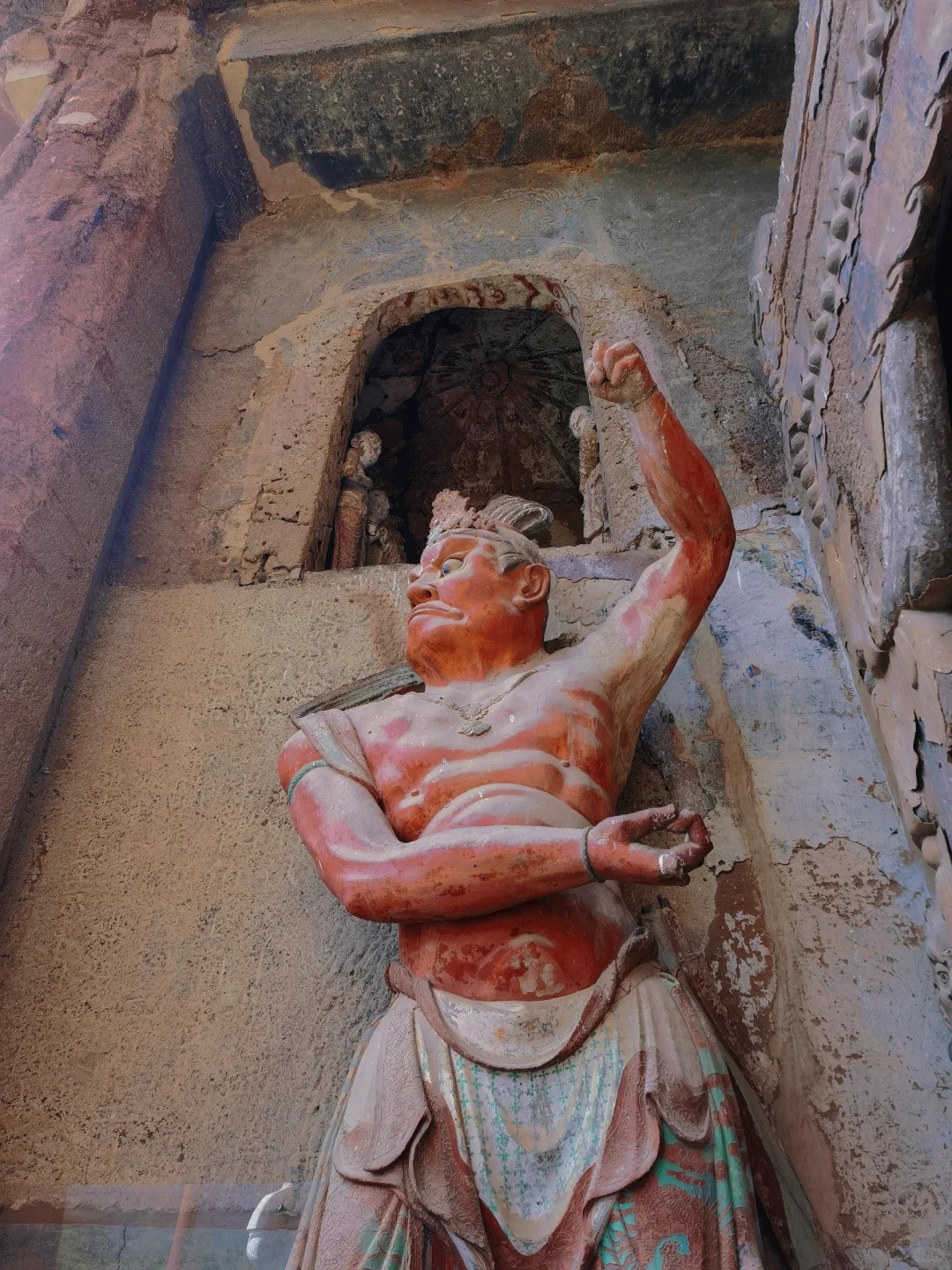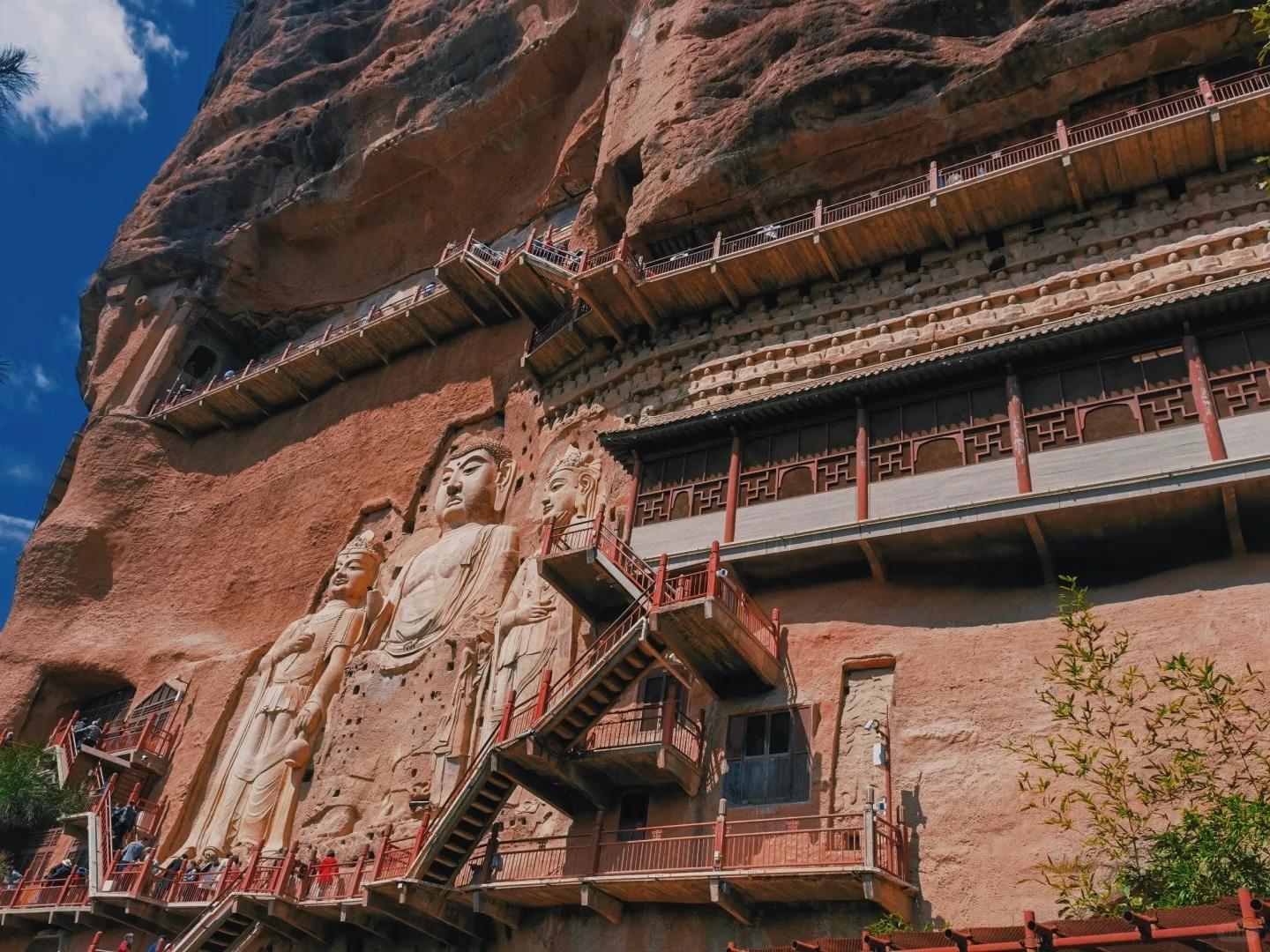Visiting Information
| Information | Details |
|---|---|
| Chinese Name | 麦积山石窟 (Màijīshān Shíkū) |
| Location and Address | Maijishan Scenic Area, Tianshui City, Gansu Province, China |
| Opening Time/Hours | 8:00 AM – 6:00 PM (March to November) 9:00 AM – 5:00 PM (December to February) |
| Entrance Fee | Peak Season (March to November): CNY 90 Off-Season (December to February): CNY 70 (Including shuttle bus fee) |
| How to Get There | By Bus: Take bus 34 from Tianshui City to Maijishan Scenic Area By Taxi: Available from Tianshui City, about 45 minutes drive (No metro service available in Tianshui) |
| Best Time for Visit | Spring (April to May) and Autumn (September to October) for comfortable weather and beautiful scenery |
| Contact Info | Tel: +86 938 2812323 Email: [email protected] |
Overview
The Maijishan Grottoes, located in Tianshui City, Gansu Province, China, are a series of 194 caves cut in the side of the hill of Majishan. These grottoes contain over 7,200 Buddhist sculptures and over 1,000 square meters of murals, dating from the Later Qin dynasty (384-417 CE) to the Song dynasty (960-1279 CE). The site is considered one of the four most famous Buddhist cave complexes in China, alongside the Mogao Caves, Yungang Grottoes, and Longmen Grottoes.
Historical Background
The construction of the Maijishan Grottoes began in the Later Qin dynasty and continued for about 1,000 years. The grottoes witnessed the rise and fall of several dynasties, including the Northern Wei, Western Wei, Northern Zhou, Sui, Tang, and Song. Each period left its unique artistic and cultural imprint on the caves. The grottoes survived numerous natural disasters and wars, including an earthquake in 734 CE during the Tang dynasty. They were largely forgotten after the Song dynasty until their rediscovery in the early 20th century.

Architectural Features
- Cave Structure: The grottoes are carved into the east cliff face of Maijishan, a hill that rises steeply from the valley floor. The caves are arranged in a honeycomb pattern, spread over 30 tiers. Wooden walkways and stairs, reconstructed based on ancient designs, provide access to the caves.
- Sculptures: The grottoes house over 7,200 clay sculptures, ranging from tiny figurines to colossal statues over 16 meters high. These sculptures showcase various artistic styles from different dynasties, reflecting the evolution of Buddhist art in China.
- Murals: Covering over 1,000 square meters, the murals in Maijishan Grottoes depict Buddhist stories, celestial beings, and scenes from daily life. The painting techniques and styles vary across different periods, providing valuable insights into the development of Chinese painting.
- Cave Designs: The caves vary in size and shape, from small niches to large halls. Some caves feature elaborate front porches with wooden structures, while others are simple recesses in the cliff face. The layout and design of each cave reflect the artistic and religious concepts of its time.
Cultural Importance
The Maijishan Grottoes are of immense cultural significance as they provide a comprehensive record of the development of Buddhist art in China over nearly a millennium. They showcase the fusion of Indian Buddhist art with Chinese aesthetics and the evolution of artistic styles across different dynasties. The grottoes also offer insights into the spread of Buddhism along the Silk Road and its integration with Chinese culture. As a UNESCO World Heritage Site (as part of “Silk Roads: the Routes Network of Chang’an-Tianshan Corridor”), Maijishan plays a crucial role in the study of Chinese art history, religious history, and cultural exchange between East and West.
Surrounding Attractions
- Maijishan Museum: Located at the foot of Maijishan, this museum houses numerous cultural relics excavated from the grottoes and the surrounding area. It provides visitors with a deeper understanding of the history and artistry of the Maijishan Grottoes.
- Fuxi Temple: Situated in Tianshui city, about 45 km from Maijishan, this temple is dedicated to Fuxi, a legendary ancient Chinese ruler. It’s one of the oldest and largest temples dedicated to Fuxi in China, featuring traditional Chinese architecture and beautiful gardens.
- Yuquan Temple: This Tang dynasty temple, located near Maijishan, is famous for its unique architectural style and historical significance. It houses several important cultural relics and offers a serene environment for visitors.
- Water Curtain Cave: This natural cave, located near the Maijishan Grottoes, features a waterfall that forms a “curtain” over its entrance. It’s a popular spot for visitors to enjoy the natural scenery and cool off during hot summer days.

Photography Opportunities
- Panoramic Views: The viewing platform at the top of Maijishan offers stunning panoramic views of the surrounding landscape. This spot is particularly popular for capturing sunrise and sunset shots, with the grottoes and the valley bathed in golden light.
- Cave Interiors: The intricate sculptures and colorful murals inside the caves provide excellent subjects for detail-oriented photography. The interplay of light and shadow within the caves creates interesting effects, especially in caves with front porches.
- Cliff Face: The external view of the grottoes, with their wooden walkways clinging to the cliff face, offers dramatic shots that capture the scale and unique construction of the site. Early morning or late afternoon light can create striking contrasts on the cliff face.
- Seasonal Landscape: The area around Maijishan changes dramatically with the seasons. Spring brings blooming flowers, summer offers lush greenery, autumn paints the landscape in warm colors, and winter sometimes covers the area in snow, each season providing unique photographic opportunities.
- Cultural Activities: During festivals or special events, there may be opportunities to photograph traditional performances or religious ceremonies, adding a cultural dimension to your photography.
Modern Importance
- Cultural Heritage Preservation: The Maijishan Grottoes serve as a focal point for efforts in cultural heritage preservation in China. Ongoing conservation work at the site contributes to the development of restoration techniques and strategies for protecting ancient cave art.
- Tourism Development: As a major tourist attraction, Maijishan plays a significant role in the local economy of Tianshui and the broader Gansu province. It helps promote cultural tourism and contributes to the economic development of this historically underdeveloped region.
- Educational Resource: The grottoes serve as an invaluable educational resource for students, researchers, and art enthusiasts. They provide tangible examples of Chinese Buddhist art history, aiding in the understanding and appreciation of China’s cultural heritage.
- International Cultural Exchange: As part of the UNESCO World Heritage Site of the Silk Roads, Maijishan contributes to international cultural exchange and understanding. It helps showcase China’s rich cultural history to a global audience and promotes cross-cultural dialogue.
- Scientific Research: The Maijishan Grottoes continue to be an important site for archaeological and art historical research. Ongoing studies of the sculptures, murals, and construction techniques provide new insights into ancient Chinese art, technology, and society.

FAQ
- What are the Maijishan Grottoes famous for?
The Maijishan Grottoes are famous for their extensive collection of Buddhist cave art, including thousands of clay sculptures and murals dating from the 4th to 13th centuries CE. - What’s inside the Maijishan Grottoes?
Inside the Maijishan Grottoes, you’ll find 194 caves containing over 7,200 Buddhist sculptures and more than 1,000 square meters of murals, showcasing various artistic styles from different Chinese dynasties. - Are the Maijishan Grottoes free?
No, the Maijishan Grottoes are not free. There is an entrance fee that varies depending on the season, which includes the cost of the shuttle bus within the scenic area. - Are the Maijishan Grottoes worth visiting?
Yes, the Maijishan Grottoes are generally considered worth visiting for their historical significance, impressive Buddhist art, and unique cliff-side architecture. - What to do in the Maijishan Grottoes?
At the Maijishan Grottoes, you can explore the cave art, visit the on-site museum, enjoy panoramic views from the viewing platform, and hike in the surrounding scenic area. - How do I get to the Maijishan Grottoes in the local city?
In Tianshui City, you can take bus 34 from the city center to the Maijishan Scenic Area, or take a taxi which takes about 45 minutes. - How to visit the Maijishan Grottoes?
To visit the Maijishan Grottoes, arrive at the scenic area, purchase tickets at the entrance, take the shuttle bus to the grottoes area, and then explore the caves via the wooden walkways. It’s recommended to allow at least half a day for the visit.



